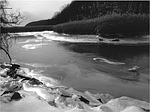Fate of Piermont Marsh Still Uncertain
More than a year ago the New York Department of Environmental Conservation announced that it planned to eradicate the tall common reed, also known as phragmites, from the Piermont Marsh using herbicides. DEC considers phragmites an invasive species that they say tends to suppress biological diversity.
The funding for this project is tied to remedial compensation for environmental damage caused by construction of the New Tappan Zee Bridge. After three “Fact Finding” meetings held by the DEC in Piermont during the last six months, the fate of the Marsh is still undecided.
The past three public meetings focused, respectively, on the evolution and current state of the marsh’s ecology; whether pollution and excessive nutrients in the Hudson and Sparkill Creek may have contributed to the dominance of phragmites; and the ability of the marsh and its tall dense phragmites to protect adjacent residential neighborhoods from excessive storm wave action and debris impact, such as seen elsewhere during Hurricane Sandy at shores unprotected by marsh and tall reeds.
A fourth meeting to be held probably in March (date to be announced), will focus on whether, or how, to intervene in the Marsh’s ecology. Neighbors in both Palisades and Piermont still have no assurance from the DEC that herbicides, with their potential health side effects, will not be used; that the cure is not worse than the alleged disease; how the current significant bird, fish, and amphibian population, and other marsh life would fare; whether the marsh would erode during storms while it is lying fallow for some years; whether storm protection to adjacent neighborhoods would suffer; and whether phragmites would simply return after the funding tied to Tappan Zee Bridge construction would be exhausted and hence would be futile: a waste of resources that could be spent on more worthy projects.
Community members proposed alternate projects such as adding reef structures outboard of the marsh to protect it from future storm erosion amplified by sea level rise; or building reefs and planting a new marsh to protect the portions of Piermont north of the pier, that are now unprotected and have badly suffered during Sandy and earlier storms.
Look out for imminent announcements for the crucial last, fourth meeting, in the press, or on websites of the Piermont Marsh Alliance or the Official Website of the Village of Piermont. Attend the meeting and voice your support for preservation of the Marsh largely in its present form. Most consider the Marsh a treasure the way it is, that it deserves better than potentially harmful and ill-conceived man-made intervention, with little chance for sustainable success.
(Dr. Jacob is a Special Research Scientist at the Lamont-Doherty Earth Observatory and teaches a graduate course on Disaster Risk Management and Sustainable Urban Resilience at Columbia University. He serves by Appointment of the Mayor of NYC on its Panel for Climate Change and has served as a Research Adviser to US-HUD’s post-Sandy ‘Rebuild-by-Design’ Competition. He currently serves on various Water Front Resilience and Long-term Planning Task Forces on behalf of the Village of Piermont.)


